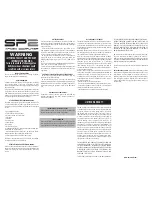
Français
53
1. INTRODUCTION
Infrared thermography detection technology has become an essential means of
guaranteeing the safety of industrial production conditions. It is used in sectors of
industry as varied as metallurgy and steel-making, electric power, the oil industry,
automation, the extraction of natural gas, the transport industry, and other
professions active in fire fighting and border surveillance. In all of these activities,
characterized by just-in-time operating procedures, production equipment at high
voltage, powerful electric currents, or high operating speeds, infrared thermal
imaging can be a useful contact-free real-time inspection method.
This detection method requires no breaking of current, no stopping of machines or
interruption of production. It can diagnose latent defects in advance, and so
forestall the occurrence of malfunctions and prevent production incidents. Thermal
imaging is an innovative "contact-free" evaluation technique that is all at once safe,
reliable, and rapid.
A thermal camera does not measure temperatures, but radiant fluxes. After the
adjustment of a few parameters by the thermography operator, the camera
calculates the temperatures of the target. It then gives the user a map of the
temperatures, or "thermogram": each temperature is represented by a colour.
Here are two examples of thermograms:
Inside views of three-phase electrical boxes
First of all, we can see that these two thermograms are practically identical: we
observe one phase that is hotter than the other two (the one on the left in the left-
hand thermogram, the top one in the right-hand thermogram). As it happens, their
colour is light yellow, which indicates according to the colour scale to the right of
the IR image that the temperature is higher there.
Let's take a closer look at these two images, by inserting temperature cursors.
English
Содержание C.A 1875
Страница 99: ...Fran ais 98 English...
















































